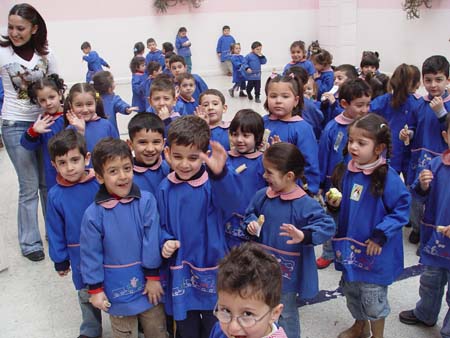
On Thursday morning (March 23), Der Hayr (Fr.) Zareh collects me at the Prelacy to visit a few of the several Armenian schools in the city. Our first stop is at the Zavarian National School, founded in 1925, for children in the primary grades (JK to Grade 6). Baron Raffi, the Director of the School, meets us and takes time to show us around the school. While visiting one of the kindergarten classrooms, the morning recess bell rings, and the school's courtyard explodes with the delighted screams and laughter of the school's population of nearly 500 children.

Fr Zareh (pictured here in the Kindergarten playroom with Director Raffi) is particularly interested in the school because it is likely that his 2 year old son Hamo will begin Junior Kindergarten here in a couple of years.
We then go on to visit a large complex of Armenian institutions founded on property purchased by the Danish Christian philanthropist Karen Yeppe in the early 1920s in response to the humanitarian crisis following the Armenian genocide.

There are now two schools (primary and senior) and a church on the property, and Karen Yeppe's bust overlooks the sprawling courtyard of the complex's senior school, the Karen Yeppe National College or Gemaren (like the German Gymnasium). We we enjoy an informative conversation with the school's director, Baron Vahe Ghazaria in the company of two of the members of his Board of Directors.

Director Ghazaria then takes us on a tour of the school and one of the 10th year classes welcomes a new student (back row) from Canada! These young people are quite impressive — warm and welcoming, full of good cheer, and clearly talented. There are more than a thousand students in the school and one cannot help but admire their relatively unencumbered social universe. Armenian is the language of instruction in the school, but I learn that Arabic becomes more prominent in the final years as the students prepare for Syria's gruelling slate of university entrance exams. Admission to Medical School, for instance, requires what Director Ghazaria considers a miraculous result of 98% or better!

Next door to the high school is the Sahagian Mixed School, another primary school, part of the original foundation of the property (the school was founded in 1922 and its first building is seen here in a photo from 1927.) Today nearly 900 children attend classes at the Sahagian National School.
I particularly enjoy meeting the director of this school, Baron Jirair
Reisian. He has studied abroad and his English is quite fluent, something of a
rarity in Aleppo. Among other things, he is passionate about music; and he is
the director of a local chamber ensemble that specialises in the music of the
European Renaissance. The group offers 5-6 concerts each year, performed on modern
instruments (due to the lack of other available options) and in some interesting
configurations — for instance, a recorder combined with piano and guitar (in
place of harpsichord and lute). Director Reisian, pictured here playing a
harmonium, is also a proficient vocalist and is one of the very few in the
Armenian world who can still read the ancient Armenian system of musical
notations (marks placed above the words in a printed text indicating the notes
in a range of 5 octaves). As I recall this works with symbols for notes in the
basic octave, like a small "o" (º) inserted above a syllable, and with score
marks (`) in either direction to indicate the octaves (one or two) above and
below.
5-6 concerts each year, performed on modern
instruments (due to the lack of other available options) and in some interesting
configurations — for instance, a recorder combined with piano and guitar (in
place of harpsichord and lute). Director Reisian, pictured here playing a
harmonium, is also a proficient vocalist and is one of the very few in the
Armenian world who can still read the ancient Armenian system of musical
notations (marks placed above the words in a printed text indicating the notes
in a range of 5 octaves). As I recall this works with symbols for notes in the
basic octave, like a small "o" (º) inserted above a syllable, and with score
marks (`) in either direction to indicate the octaves (one or two) above and
below.
 Following our visit with Director Reisian, we move on to the third
institution on the site originally purchased by Karen Yeppe, a beautiful
Armenian Orthodox Church dedicated to Sourp Krikor Lousavorich (St. Gregory the
Illuminator), about half the size of its namesake, the Cathedral at the Armenian
Catholicosate in Antelias, Lebanon. The building has a very pleasant design,
featuring four central columns at the transept that support a lofty decorated
dome.
Following our visit with Director Reisian, we move on to the third
institution on the site originally purchased by Karen Yeppe, a beautiful
Armenian Orthodox Church dedicated to Sourp Krikor Lousavorich (St. Gregory the
Illuminator), about half the size of its namesake, the Cathedral at the Armenian
Catholicosate in Antelias, Lebanon. The building has a very pleasant design,
featuring four central columns at the transept that support a lofty decorated
dome.
Our tour of the schools completed, Fr. Zareh stops near his home to treat me
to some sweets from a local pastry shop in the Christian neighbourhood (mostly
Armenian) of Nor Kugh (literally, "new village" in Armenian taking the place of
the "old villages" left behind when the Armenians were evicted from their homes
in Turkey.) It is a crowded neighbourhood, which Fr. Zoreh and others jokingly
refer to as Aleppo's Bouj Hammoud (the jostling and jampacked Armenian neighbour
in Beirut.)
from a local pastry shop in the Christian neighbourhood (mostly
Armenian) of Nor Kugh (literally, "new village" in Armenian taking the place of
the "old villages" left behind when the Armenians were evicted from their homes
in Turkey.) It is a crowded neighbourhood, which Fr. Zoreh and others jokingly
refer to as Aleppo's Bouj Hammoud (the jostling and jampacked Armenian neighbour
in Beirut.)
Fr. Zareh then drives me to meet my guide for the second
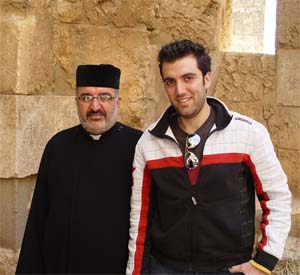 portion of the day's
schedule of site seeing, Fr. Datev, pictured here with our interpreter and
driver, Hyrant Zaki — Fr. Datev's English is only slightly better than my
Armenian (we do manage to have a small conversation about his family as we drive
together to meet Hyrant, but communication is decidedly limited.) I am
particularly keen to meet Fr. Datev because he is the father
portion of the day's
schedule of site seeing, Fr. Datev, pictured here with our interpreter and
driver, Hyrant Zaki — Fr. Datev's English is only slightly better than my
Armenian (we do manage to have a small conversation about his family as we drive
together to meet Hyrant, but communication is decidedly limited.) I am
particularly keen to meet Fr. Datev because he is the father of one of my students
at the seminary in Bikfaya. Perhaps you will remember Deacon Christopher,
pictured here, the seminary's official photographer who took a wonderful set of
photos for me of a Badarak (Armenian Divine Liturgy) in early February. I am
told that if I want to know what Fr. Datev was like as a young man, I need only
look at his son Deacon Christopher. Both father and son are characteristically
delightful — the fruit, it is said, falls close to the tree!
of one of my students
at the seminary in Bikfaya. Perhaps you will remember Deacon Christopher,
pictured here, the seminary's official photographer who took a wonderful set of
photos for me of a Badarak (Armenian Divine Liturgy) in early February. I am
told that if I want to know what Fr. Datev was like as a young man, I need only
look at his son Deacon Christopher. Both father and son are characteristically
delightful — the fruit, it is said, falls close to the tree!
Hyrant Zikka English is quite fluent. He all but completed a B.A. in Business Administration at the American University in Beirut (interrupted in the wake of the Hariri bombing when things became rather unpleasant for native Syrians;) and he lived in Pasadena, California, with his family long enough to obtain US citizenship.
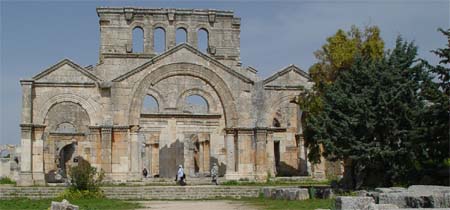
Our principal destination for the afternoon, is the famous pilgrimage church of St. Simeon near the border with Turkey to the north and east of Aleppo. Known as "Qala'at Samaan in Arabic, this was one of the greatest (in size and importance) churches in the Christian world during the second half of the first millennium. St. Simeon was the first of the Stylites, early Christian ascetics who lived unsheltered on the tops of high pillars (stylos). The son of a shepherd, he joined a monastery at an early age, but found his life lacking in austerity and took up residence in a cave in the barren hills nearby. Word of his extreme piety spread and so many came to seek his blessing, that the monk took up residence atop a pillar "high above the maddening crowd." It took only fourteen years following his death in 459, for the enormous church to be built around the saints lofty home.

The design is somewhat unusual, there are four basilicas surrounding the
saint's pillar located in a central covered courtyard. The shape of the entire
structure is cruciform with the main or head portion (at the back of the
photo, above) tilted slightly to the left, representing the tilted head of the Saviour
on the cross. The holy stylos can be seen here, now worn down by memento seekers
to a bare stump with a round bolder perched upon it. The sight is wonderful to
visit, and is perched on a wooded plateau rising above the rocky country side.
It is very pleasant spending time with Fr. Datev and Hyrant. Our conversation is
free flowing and very informative. We travel in style, Hyrant has borrowed his
mothers BMW X5 (a SUV) for the day, his own BMW coupe a bit too closed quarters
for the three of us.
above) tilted slightly to the left, representing the tilted head of the Saviour
on the cross. The holy stylos can be seen here, now worn down by memento seekers
to a bare stump with a round bolder perched upon it. The sight is wonderful to
visit, and is perched on a wooded plateau rising above the rocky country side.
It is very pleasant spending time with Fr. Datev and Hyrant. Our conversation is
free flowing and very informative. We travel in style, Hyrant has borrowed his
mothers BMW X5 (a SUV) for the day, his own BMW coupe a bit too closed quarters
for the three of us.

We drive through some very rugged terrain, inhabited by sheep and goats and their herders, with the occasional stretch of irrigated farmland and at least one small farm vehicle carrying a great load of freshly harvested produce — possibly thyme?
We return to Aleppo through the newer and trendier area to the north of the
city, where there is much development underway. This includes a new roundabout
dedicated to the memory of President Bashar Assad's late brother Basil, the
long-time heir apparent to his father Hafez. Basil was killed in a high-speed
car accident in 1994 with the result that the younger Bashar was whisked away
from his ophthalmology studies at Saint Mary's Hospital in London to begin his
political apprenticeship, eventually taking his place as President of Syria
following his father's death in 2000. The new president's brother, Basil, was a
very popular man and his portrait can still be seen in the windows of many a car
or home in Syria today. This statue is the work of an Armenian artist from
Aleppo, and it is clearly a source for pride among local Armenians.
to the north of the
city, where there is much development underway. This includes a new roundabout
dedicated to the memory of President Bashar Assad's late brother Basil, the
long-time heir apparent to his father Hafez. Basil was killed in a high-speed
car accident in 1994 with the result that the younger Bashar was whisked away
from his ophthalmology studies at Saint Mary's Hospital in London to begin his
political apprenticeship, eventually taking his place as President of Syria
following his father's death in 2000. The new president's brother, Basil, was a
very popular man and his portrait can still be seen in the windows of many a car
or home in Syria today. This statue is the work of an Armenian artist from
Aleppo, and it is clearly a source for pride among local Armenians.

Pictures of President Bashar Assad are manifold throughout Aleppo, more-so than usual, I am told, with many portraits being hung to welcome the young President who made an official visit to the city — only a few days before my own much less official arrival here — for the opening of the "World Capital of Islamic Culture" celebrations on March 18th. A conversation with Johnny, my guide in Aleppo the previous evening, helps clarify the political situation in Syria. Johnny notes that, by western standards, it is true that the Syrian system can seem oppressive but, he insists, for the Christian population, this system, in the context of the Middle East, provides stability and security for the people of Syria, especially for its minorities. As the situation in Iraq illustrates all too clearly, greater democracy in this troubled region does not necessarily lead to greater peace and security.

The work of other Armenian artists decorate the offices of Lezaco, a company
distributing electrical power tools in Syria that is owned and operated by
Hyrant's father Baron Levon (Leon) Zaki pictured here with his son. Hyrant
really enjoys the family business and working with his father, he has most
graciously taken the day off today to serve as my guide and interpreter. Levon
has a series of clocks lined up in the outer office which he can see through a
window from his desk. The clocks give the time in various time zones around the
world. "This way I know," Levon explains, "if the businessman I am talking with
in Tokyo has just arrived at work or is at the end of a long day!" The art work
in the office is particularly fine, including this handsome statue in pewter of
a powerful stallion.
business and working with his father, he has most
graciously taken the day off today to serve as my guide and interpreter. Levon
has a series of clocks lined up in the outer office which he can see through a
window from his desk. The clocks give the time in various time zones around the
world. "This way I know," Levon explains, "if the businessman I am talking with
in Tokyo has just arrived at work or is at the end of a long day!" The art work
in the office is particularly fine, including this handsome statue in pewter of
a powerful stallion.
 After
a short visit at the Lezaco offices, we drive into the old city, for a late
lunch at the Sissi House, a popular Armenian owned Restaurant very near the
Armenian Prelacy. The Zakis are not strangers here, and they are welcomed as to
the home of a dear friend. A large group of European tourists is having lunch on
the main floor of the restaurant, and we take our places in an alcove on a
higher level across from a musician playing the Arabian oud.
After
a short visit at the Lezaco offices, we drive into the old city, for a late
lunch at the Sissi House, a popular Armenian owned Restaurant very near the
Armenian Prelacy. The Zakis are not strangers here, and they are welcomed as to
the home of a dear friend. A large group of European tourists is having lunch on
the main floor of the restaurant, and we take our places in an alcove on a
higher level across from a musician playing the Arabian oud.

Baron Levon orders mezze (of course!) and shish kebab; and Fr. Datev and I
agree that the occasion warrants a brief lapse from the usual austerities of the
Lenten diet. As to the question, "What to drink?" there is little hesitation and
a waiter arrives with the refreshing elixir of the Middle East, Arak — lion's
milk — in the same family of beverages as the French pastis (Pernod &
Richard) and the Greek ouzo.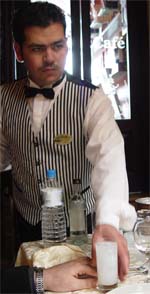 When water is added to this clear liqueur, the mixtures
takes on a cloudy white hew (hence the "milk" of the lion). It is really
refreshing on a hot day and it is not surprising that such a concoction is
associated with the balmy shores the Mediterranean Sea. Soon the side dishes of
the mezze arrive and fill the table with vivid colours and a melange of savoury
aromas. Dr. Manuel Iskanderian happens upon table and joins us for lunch. He is
a good friend of Levon Zaki's and the chair of the Executive Committee — on
which Levon also serves — for the Armenian Prelacy. The Armenian national
constitution (150 years old) establishes national executives like the one at the
Prelacy, with the bishop or prelate providing oversight, and the lay members of
the board, rather like the members of a cabinet of ministers, taking
responsibility for various aspects of government and mission in the Prelacy. Dr.
Iskanderian is a dentist, and he is particularly
When water is added to this clear liqueur, the mixtures
takes on a cloudy white hew (hence the "milk" of the lion). It is really
refreshing on a hot day and it is not surprising that such a concoction is
associated with the balmy shores the Mediterranean Sea. Soon the side dishes of
the mezze arrive and fill the table with vivid colours and a melange of savoury
aromas. Dr. Manuel Iskanderian happens upon table and joins us for lunch. He is
a good friend of Levon Zaki's and the chair of the Executive Committee — on
which Levon also serves — for the Armenian Prelacy. The Armenian national
constitution (150 years old) establishes national executives like the one at the
Prelacy, with the bishop or prelate providing oversight, and the lay members of
the board, rather like the members of a cabinet of ministers, taking
responsibility for various aspects of government and mission in the Prelacy. Dr.
Iskanderian is a dentist, and he is particularly responsible for the 21
Armenian schools and their 7,000 students in the city of Aleppo. Baron Zaki is
in charge of planning for the diocese.
responsible for the 21
Armenian schools and their 7,000 students in the city of Aleppo. Baron Zaki is
in charge of planning for the diocese.
Following a wonderful lunch, Hyrant Zaki takes me down to the cellar of the restaurant to see the entrance to a passage way (now sealed) which once opened into a series of underground tunnels in Old Aleppo that lead to the citadel (see yesterday's post). In the case of an attack or other emergency, the one time occupants of the house could flee to the safety of the fortified citadel through these underground passageways — a system that would have been put to good use as recently as World War II.

After leaving the restaurant, we drop Levon off near the downtown offices of his family business; and Hyrant kindly takes me over to an Armenian social club were there is an internet café with high-speed access to the internet. I have my usb memory stick with me, and I am able to add a post to the blog from the internet café — the post about the Syrian Divine Liturgy (see below). I also check my email.

Hyrant drives me back to the Prelacy around 8 p.m. The downtown sector is alive with coloured lights, like these decorating the palm trees in a city square, part of the decorations associated with Aleppo's status as World Capital of Islamic Culture for 2006.
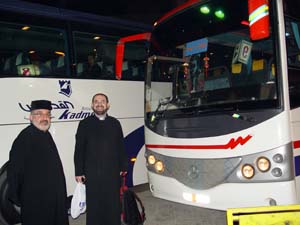
After Hyrant drops me off at the Prelacy, I have a couple of hours to pack and rest before being collected by Fr. Zareh and Fr. Datev for the ride to a busy bus depot to board my bus for an over night trip to the desert city of Der ez-Zur (about 100 kilometres from the Iraqi border), to visit the Armenian churches that commemorate the hundreds of thousands of Christians slaughtered in the Syrian desert at the hands of the Ottoman Turks.







